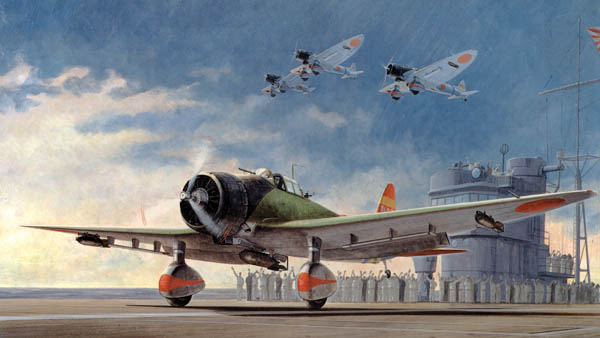

![]()

AICHI D3A1 VAL
Navy single-engined two-seat carrier-based dive bomber.
| Der
Aichi D3A1, Typ 99, Serie II wurde 1936 nach japanischen
Marinespezitikationen für einen neuen Bomber gebaut, der auf Flugzeugträgern
stationiert wurde. Er war der Ersatz des Aichi DIA2-Zweideckers und das
erste Flugzeug, das die amerikanischen Ziele bei Pearl Harbour am 7.
Dezember 1941 bombardierte. Das Design war teilweise vom Heinkel 70
inspiriert, d.h., die Tragflächen hatten eine ähnliche Form, aber beim
Aichi-Design wurde das feste Fahrgestell beibehalten. Der Prototyp flog
erstmals im Januar 1938, war aber nicht hochtourig genug, und manche Teile
waren anfällig. Beim zweiten Prototyp wurden diese Probleme jedoch gelöst.
Im Wettbewerb mit anderen Herstellern bekam Aichi 1939 den Auftrag, sechs
Probe- und 470 Serienflugzeuge für die Marine zu bauen. Ihre Tragflächen
hatten eine etwas reduzierte Spannweite und Fläche. Trotz der Größe und
des Gewichtes hatte das Flugzeug nach dem Einbau der Seitenflosse die
Wendigkeit eines Jägers. Nach Probeflügen von Flugzeugträgern flogen
die D3A1 zum ersten Male 1940 im Krieg zwischen China und Japan. Später
haben ca. 126 D3A1 an den Angriffen auf Pearl Harbour teilgenommen, Sie
waren auch mit allen bedeutenden Flugzeugträgereinsätzen für die nächsten
10 Monate verwickelt. Zuerst erzielten sie eine sehr hohe Bombardierpräzision.
Die Vals (der alliierte Deckname) mußten schwere Verluste in den großen
Schlachten hinnehmen, die im Korallenmeer, bei Midway, Guadalcanal und den
Solomonen stattfanden. Dies lag teilweise an der verbesserten Leistung der
alliierten Kampfjäger und den erfahrenen Piloten sowie auch an den
Verlusten der japanischen Flugzeugträger. Viele Vals mußten von Landstützpunkten
fliegen, deshalb produzierte Aichi die verbesserten Langstrecken-Vals
D3A2, die mit den ständig größeren Entfernungen im Pazifik fertig
werden sollten. Sie verdrängten Ende 1942 die frühere Version beim
Fronteinsatz. Als die vielen von Aichi produzierten Yokosuka-D4Y2-Suisei-Stukas
1943 den Dienst antraten, wurden die Vals zu den kleineren
Begleitflugzeugträgern oder Landstützpunkten als Trainingsflugzeuge
relegiert. Ihr Schwanengesang kam im letzten Kriegsjahr, als viele ältere
Vals wieder an der Front eingesetzt werden mußten, diesmal aber als die
ziemlich erfolglosen und sehr anfälligen Kamikaze-Flugzeuge. Die ersten
Vals D3A1 hatten einen 1000PS Mitsubishi-Kinsei 14-Zylindersternmotor und
eine Höchstgeschwindigkeit von 386km/h (240mph) bei 2.998m (9.845 Fuß).
Sie waren mit zwei vorwärts und einem rückwärts schießenden 7.7mm
Maschinengewehren bewaffnet und konnten eine 250kg (551 Pfund) Bombe unter
dem Rumpf und zwei 60kg (132 Pfund) Bomben unter den Tragflächen tragen. |
Designed
to specifications issued by the Japanese Navy in 1936 for a new carrier-borne
bomber to replace the Aichi DIA2 biplane, the Aichi D3A1 Type 99 Carrier
Bomber Model II was destined to be the first Japanese type to bomb
American targets at Pearl Harbour an 7 December 1941. The design was
partially inspired by the German Heinkel 70, the wing shapes being very
similar, although the Aichi design retained a fixed undercarriage. The
prototype first flew in January 1938, and proved to be underpowered and
suffering from some unstable characteristics, although these problems were
solved in the second prototype. In competition with other types during
1939, Aichi won an order to build six trials and 470 production aircraft
for the Navy; these featured wings of slightly reduced span and area.
Despite its size and weight, when the dorsal fin was fitted the aircraft
had fighter-style maneuverability; following carrier trials, the first
operational D3A1s undertook combat missions in 1940 from the Chinese
mainland during the war with that country. Later some 126 D3A1s took part
in the Pearl Harbour attack, and the type was involved in all major
carrier operations for the next 10 months, achieving very high bombing
accuracies in the early days. Code-named VAL by the allies, it began to
suffer heavy losses in the huge battles which occurred in the Coral Sea,
at Midway, Guadalcanal and in the Solomon Islands; this was due in part to
the improved performances of allied fighter aircraft and the experience of
the their pilots, and also to the losses amongst the Japanese carrier
forces. Many Vals were forced to operate from shore bases, and to cope
with the ever-increasing. distances involved in the Pacific theatre Aichi
produced the improved longer range D3A2 Val. These supplanted the earlier
version in front line use by the end of 1942, and when the Yokosuka D4Y2
Suisei dive bomber - many of which were produced by Aichi - entered
service from 1943, Vals were increasingly relegated to the smaller escort
carriers or to land bases as trainers. Their swan song came during the
final year of the war when many elderly Vals were again pressed into front
line service, but this time as not very effective and very vulnerable
kamikaze bombers. Powered by a 1,000 hp Mitsubishi Kinsei 14-cylinder
radial engine, the early D3A1 Val had a maximum speed of 386km/h (240mph)
at 2,998m (9,845ft).1t was armed with two forward-firing and one rearward-firing
7.7mm machine guns and could carry one 250kg (5511b) bomb under the
fuselage and two 60kg (1321b) bombs under the wings. ... more |

|
Here is a quick overview of all different versions, without the full technical specifications:
Remarks: The Val was initially very successfull, and sunk a number of ships during the attack on Pearl Harbor in 1941. They sunk more Allied ships then any other type during World War 2. In the beginning of the war they had a hit ratio of over 80%, also due to the well trained crews. In the year 1942 however the weaknesses started to show: due to the slow speed they proved very vulnerable and were taken out of active duty from 1943 on. In 1945 the leftovers made a dubious comeback, this time as kamikaze planes. Even in this last role they were ineffective due to the firm air superiority the allied forces had gained. Strengths
Weaknesses
|
||||||||||||||||||||||||||||||||||||||||||||||||||||||||||||||||||||||||||||||||||||||||||||||||||||||||||||||||||||||||||||||||||||||||||